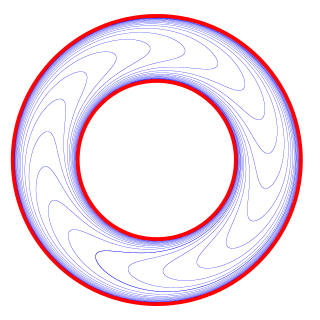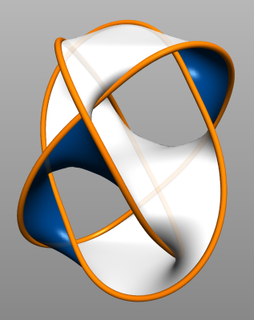In mathematics, an embedding is one instance of some mathematical structure contained within another instance, such as a group that is a subgroup.
In differential geometry, a Riemannian manifold or Riemannian space(M, g) is a real, smooth manifold M equipped with a positive-definite inner product gp on the tangent space TpM at each point p. A common convention is to take g to be smooth, which means that for any smooth coordinate chart (U, x) on M, the n2 functions
The theory of functions of several complex variables is the branch of mathematics dealing with complex-valued functions. The name of the field dealing with the properties of function of several complex variables is called several complex variables, that has become a common name for that whole field of study and Mathematics Subject Classification has, as a top-level heading. A function is n-tuples of complex numbers, classically studied on the complex coordinate space .

In mathematics, a foliation is an equivalence relation on an n-manifold, the equivalence classes being connected, injectively immersed submanifolds, all of the same dimension p, modeled on the decomposition of the real coordinate space Rn into the cosets x + Rp of the standardly embedded subspace Rp. The equivalence classes are called the leaves of the foliation. If the manifold and/or the submanifolds are required to have a piecewise-linear, differentiable, or analytic structure then one defines piecewise-linear, differentiable, or analytic foliations, respectively. In the most important case of differentiable foliation of class Cr it is usually understood that r ≥ 1. The number p is called the dimension of the foliation and q = n − p is called its codimension.
In mathematics and especially differential geometry, a Kähler manifold is a manifold with three mutually compatible structures: a complex structure, a Riemannian structure, and a symplectic structure. The concept was first studied by Jan Arnoldus Schouten and David van Dantzig in 1930, and then introduced by Erich Kähler in 1933. The terminology has been fixed by André Weil. Kähler geometry refers to the study of Kähler manifolds, their geometry and topology, as well as the study of structures and constructions that can be performed on Kähler manifolds, such as the existence of special connections like Hermitian Yang–Mills connections, or special metrics such as Kähler–Einstein metrics.
This is a glossary of terms specific to differential geometry and differential topology. The following three glossaries are closely related:

In mathematics, a submanifold of a manifold M is a subset S which itself has the structure of a manifold, and for which the inclusion map S → M satisfies certain properties. There are different types of submanifolds depending on exactly which properties are required. Different authors often have different definitions.

In mathematics, geometric topology is the study of manifolds and maps between them, particularly embeddings of one manifold into another.
In differential geometry, a Poisson structure on a smooth manifold is a Lie bracket on the algebra of smooth functions on , subject to the Leibniz rule
In mathematics, certain systems of partial differential equations are usefully formulated, from the point of view of their underlying geometric and algebraic structure, in terms of a system of differential forms. The idea is to take advantage of the way a differential form restricts to a submanifold, and the fact that this restriction is compatible with the exterior derivative. This is one possible approach to certain over-determined systems, for example, including Lax pairs of integrable systems. A Pfaffian system is specified by 1-forms alone, but the theory includes other types of example of differential system. To elaborate, a Pfaffian system is a set of 1-forms on a smooth manifold.
In mathematics, a Killing vector field, named after Wilhelm Killing, is a vector field on a Riemannian manifold that preserves the metric. Killing fields are the infinitesimal generators of isometries; that is, flows generated by Killing fields are continuous isometries of the manifold. More simply, the flow generates a symmetry, in the sense that moving each point of an object the same distance in the direction of the Killing vector will not distort distances on the object.
In differential geometry, the Laplace–Beltrami operator is a generalization of the Laplace operator to functions defined on submanifolds in Euclidean space and, even more generally, on Riemannian and pseudo-Riemannian manifolds. It is named after Pierre-Simon Laplace and Eugenio Beltrami.

In mathematics, a differentiable manifold is a type of manifold that is locally similar enough to a vector space to allow one to do calculus. Any manifold can be described by a collection of charts, also known as an atlas. One may then apply ideas from calculus while working within the individual charts, since each chart lies within a vector space to which the usual rules of calculus apply. If the charts are suitably compatible, then computations done in one chart are valid in any other differentiable chart.

The positive energy theorem refers to a collection of foundational results in general relativity and differential geometry. Its standard form, broadly speaking, asserts that the gravitational energy of an isolated system is nonnegative, and can only be zero when the system has no gravitating objects. Although these statements are often thought of as being primarily physical in nature, they can be formalized as mathematical theorems which can be proven using techniques of differential geometry, partial differential equations, and geometric measure theory.
In mathematics, a CR manifold, or Cauchy–Riemann manifold, is a differentiable manifold together with a geometric structure modeled on that of a real hypersurface in a complex vector space, or more generally modeled on an edge of a wedge.
In mathematics, in particular in nonlinear analysis, a Fréchet manifold is a topological space modeled on a Fréchet space in much the same way as a manifold is modeled on a Euclidean space.
In mathematics, specifically in geometric topology, surgery theory is a collection of techniques used to produce one finite-dimensional manifold from another in a 'controlled' way, introduced by John Milnor (1961). Milnor called this technique surgery, while Andrew Wallace called it Spherical Modification. The "surgery" on a differentiable manifold M of dimension , could be described as removing an imbedded sphere of dimension p from M. Originally developed for differentiable manifolds, surgery techniques also apply to piecewise linear (PL-) and topological manifolds.
In topology, a branch of mathematics, local flatness is a property of a submanifold in a topological manifold of larger dimension. In the category of topological manifolds, locally flat submanifolds play a role similar to that of embedded submanifolds in the category of smooth manifolds. Local flatness and the topology of ridge networks is of importance in the study of crumpled structures with importance in materials processing and mechanical engineering.
In mathematics, a harmonic morphism is a (smooth) map :(M^{m},g)\to (N^{n},h)} between Riemannian manifolds that pulls back real-valued harmonic functions on the codomain to harmonic functions on the domain. Harmonic morphisms form a special class of harmonic maps i.e. those that are horizontally (weakly) conformal.
In geometry, a valuation is a finitely additive function on a collection of admissible subsets of a fixed set with values in an abelian semigroup. For example, the Lebesgue measure is a valuation on finite unions of convex bodies of Euclidean space . Other examples of valuations on finite unions of convex bodies are the surface area, the mean width, and the Euler characteristic.










